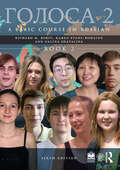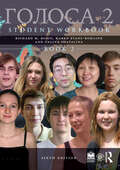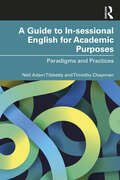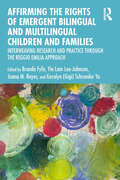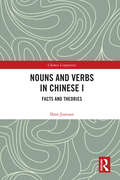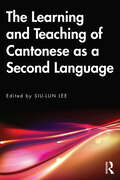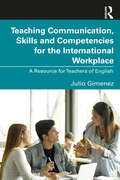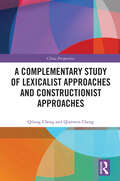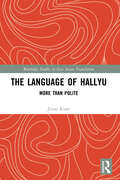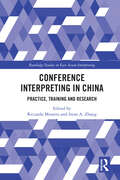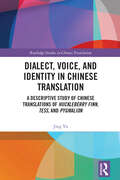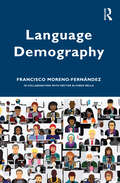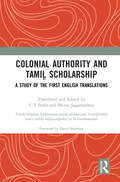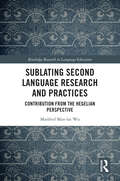- Table View
- List View
Golosa: A Basic Course in Russian, Book Two
by Richard M. Robin Karen Evans-Romaine Galina ShatalinaГОЛОСА: A Basic Course in Russian, Book Two (Sixth Edition), takes a contemporary approach to language learning by focusing on the development of functional competence as well as the expansion of cultural knowledge.The sixth edition of this bestselling communicatively based text for Russian has been updated by putting a greater focus on contemporary culture and simplified, visual grammar explanations that will better engage students. The program also covers the basic morphology of Russian (declension, case government, conjugation). The program has been a bestseller as a college Russian textbook through five editions since 1993.Following on from Golosa Book One, Golosa Book Two is divided into ten units. Organised thematically, each unit contains dialogs, texts, exercises, and other material designed to enable students to read, speak, and write about the topic, as well as to understand simple conversations. The systematic grammar explanations and exercises enable students to develop a conceptual understanding and partial control of all basic Russian structures. This strong structural base enables students to accomplish the linguistic tasks and prepares them for further study of the language. Book Two is designed to bring students to the ACTFL Intermediate range in speaking (A2/B1 on the CEFR scale).Print and eTextbooks are accompanied by a Student Workbook and a rich companion website (www.routledge.com/cw/golosa) offering audio and video material, instructor resources and fully integrated exercises to use alongside the text. The companion website, powered by Lingco, is available for separate purchase from Lingco. Teachers can preview the new companion websites and create their courses. Free audio and video resources are also available at www.routledge.com/cw/golosa, including the Instructor Resources. For resources on how to set up and customize your course, please visit the Help Center on the Lingco Language Labs website at www.lingco.io. It includes articles that explain how the platform works and what you can do with it. Students may join their teacher’s course on Lingco and will be able to enter their access code or purchase access at any point in the 14-day grace period that begins on the first date of access. Students receive 12 months of access that begins after a free 14-day grace period.
Golosa: Student Workbook, Book Two
by Richard M. Robin Karen Evans-Romaine Galina ShatalinaГОЛОСА: A Basic Course in Russian, Book Two (Sixth Edition), takes a contemporary approach to language learning by focusing on the development of functional competence as well as the expansion of cultural knowledge. The sixth edition of this bestselling communicatively based text for Russian has been updated by putting a greater focus on contemporary culture and simplified, visual grammar explanations that will better engage students. The program also covers the basic morphology of Russian (declension, case government, conjugation). The program has been a bestseller as a college Russian textbook through five editions since 1993. Following on from Golosa Book One, Golosa Book Two is divided into ten units. Organised thematically, each unit contains dialogs, texts, exercises, and other material designed to enable students to read, speak, and write about the topic, as well as to understand simple conversations. The systematic grammar explanations and exercises enable students to develop a conceptual understanding and partial control of all basic Russian structures. This strong structural base enables students to accomplish the linguistic tasks and prepares them for further study of the language. Book Two is designed to bring students to the ACTFL Intermediate range in speaking (A2/B1 on the CEFR scale). Free audio and video resources are also available at www.routledge.com/9780367612825, including the Instructor Resources. Print and eTextbooks are accompanied by a Student Workbook and a rich companion website (www.routledge.com/cw/golosa) offering audio and video material, instructor resources and fully integrated exercises to use alongside the text. The companion website, powered by Lingco, is available for separate purchase from Lingco. Teachers can preview the new companion websites and create their courses. For resources on how to set up and customize your course, please visit the Help Center on the Lingco Language Labs website at www.lingco.io. It includes articles that explain how the platform works and what you can do with it. Students may join their teacher’s course on Lingco and will be able to enter their access code or purchase access at any point in the 14-day grace period that begins on the first date of access. Students receive 12 months of access that begins after a free 14-day grace period.
A Guide to In-sessional English for Academic Purposes: Paradigms and Practices
by Neil Adam Tibbetts Timothy ChapmanA hands-on guide for practitioners, this book prepares instructors to teach in-sessional English for Academic Purposes (ISEAP) higher education courses. As university cohorts become more diverse, there is demand for in-sessional EAP courses not only to support international students, but also increasingly as a provision for all students. This informative resource explores the varying formats of ISEAP courses and how they are embedded within and alongside students’ degree programmes in the United Kingdom and beyond. In accessible chapters, authors Neil Adam Tibbetts and Timothy Chapman present illuminating findings drawn from interviews conducted with experts in the field and highlight the challenges that students and practitioners face. Avoiding prescriptive recommendations, Tibbetts and Chapman address different models and contexts of ISEAP courses at the university level and offer guidance and tools for practice. Covering key topics such as pedagogies, logistical challenges, and the wider university context, this book not only provides a roadmap to the often ill-defined but essential domain of ISEAP but also provokes questions and ideas for further reflection, guiding the reader towards a deeper understanding of their role and development in context. Engaging and inviting, Tibbetts and Chapman’s helpful text is a necessary resource for teachers to design and lead successful ISEAP courses.
A Guide to In-sessional English for Academic Purposes: Paradigms and Practices
by Neil Adam Tibbetts Timothy ChapmanA hands-on guide for practitioners, this book prepares instructors to teach in-sessional English for Academic Purposes (ISEAP) higher education courses. As university cohorts become more diverse, there is demand for in-sessional EAP courses not only to support international students, but also increasingly as a provision for all students. This informative resource explores the varying formats of ISEAP courses and how they are embedded within and alongside students’ degree programmes in the United Kingdom and beyond. In accessible chapters, authors Neil Adam Tibbetts and Timothy Chapman present illuminating findings drawn from interviews conducted with experts in the field and highlight the challenges that students and practitioners face. Avoiding prescriptive recommendations, Tibbetts and Chapman address different models and contexts of ISEAP courses at the university level and offer guidance and tools for practice. Covering key topics such as pedagogies, logistical challenges, and the wider university context, this book not only provides a roadmap to the often ill-defined but essential domain of ISEAP but also provokes questions and ideas for further reflection, guiding the reader towards a deeper understanding of their role and development in context. Engaging and inviting, Tibbetts and Chapman’s helpful text is a necessary resource for teachers to design and lead successful ISEAP courses.
Affirming the Rights of Emergent Bilingual and Multilingual Children and Families: Interweaving Research and Practice through the Reggio Emilia Approach
Affirming the Rights of Emergent Bilingual and Multilingual Children and Families explores how the philosophy, principles, and practices of the internationally acclaimed Municipal Preschools and Infant Toddler Centers of Reggio Emilia, Italy, advance the social justice and linguistic human rights of emergent bilingual and multilingual children and their families, particularly immigrants and refugees. The book is driven by the authors’ research-based discourse including an interview with Reggio Emilia educators and direct observations in the Preschools and Infant–toddler Centers in Italy. Chapters include survey and follow-up interviews, and classroom examples from U.S. early childhood educators inspired by the Reggio Emilia approach some of whom are in multilingual settings. Recommendations are included for practitioners who are intentional about advocating for the rights of emergent bi- and multilingual young children. Also included are the researchers’ interpretations and reflexive narratives on contextuality, intersectionality, and intertextuality, which interweave theories and practice. The insightful examinations of scholarly work and the critical review of the distinctive features of the Reggio Emilia philosophy contribute to an early childhood education transformative lens that challenges the status quo of inequities and foregrounds the linguistic and cultural rights of learners who speak different languages. The authors review research and theory that inform the latest developments in culturally and linguistically responsive practices in innovative early education (infant through pre-k), family participation, and teacher preparation and development. Of general interest to educators and researchers around the world who work to ensure the rights of emergent language learners, this is an essential text for upper-level and graduate students, early childhood educators, educational and community leaders, administrators, and researchers.
Affirming the Rights of Emergent Bilingual and Multilingual Children and Families: Interweaving Research and Practice through the Reggio Emilia Approach
by Brenda Fyfe Yin Lam Lee-Johnson Juana M. Reyes Geralyn Gigi Schroeder YuAffirming the Rights of Emergent Bilingual and Multilingual Children and Families explores how the philosophy, principles, and practices of the internationally acclaimed Municipal Preschools and Infant Toddler Centers of Reggio Emilia, Italy, advance the social justice and linguistic human rights of emergent bilingual and multilingual children and their families, particularly immigrants and refugees. The book is driven by the authors’ research-based discourse including an interview with Reggio Emilia educators and direct observations in the Preschools and Infant–toddler Centers in Italy. Chapters include survey and follow-up interviews, and classroom examples from U.S. early childhood educators inspired by the Reggio Emilia approach some of whom are in multilingual settings. Recommendations are included for practitioners who are intentional about advocating for the rights of emergent bi- and multilingual young children. Also included are the researchers’ interpretations and reflexive narratives on contextuality, intersectionality, and intertextuality, which interweave theories and practice. The insightful examinations of scholarly work and the critical review of the distinctive features of the Reggio Emilia philosophy contribute to an early childhood education transformative lens that challenges the status quo of inequities and foregrounds the linguistic and cultural rights of learners who speak different languages. The authors review research and theory that inform the latest developments in culturally and linguistically responsive practices in innovative early education (infant through pre-k), family participation, and teacher preparation and development. Of general interest to educators and researchers around the world who work to ensure the rights of emergent language learners, this is an essential text for upper-level and graduate students, early childhood educators, educational and community leaders, administrators, and researchers.
Nouns and Verbs in Chinese I: Facts and Theories (Chinese Linguistics)
by Shen JiaxuanAs the first volume of a two-volume set that re-examines nouns and verbs in Chinese, this book proposes the verbs-as-nouns theory, corroborated by discussions of the nature and relationship between nouns and verbs in Chinese. Seeking to break free from the shackles of Western linguistic paradigms largely based on Indo-European languages and to a great extent inappropriate for Chinese, this two-volume study revisits the nature of nouns and verbs and relevant linguistic categories in Chinese to unravel the different relationships between nouns and verbs in Chinese, English, and other languages. It argues that Chinese nouns and verbs are related inclusively rather than in the oppositional pattern found in Indo-European languages, with verbs included in nouns as a subcategory. Preliminary to the core discussion on the verbs-as-nouns framework, the author critically engages with the issues of word classes and nominalization, as well as problems with the analysis of Chinese grammar due to the noun-verb distinction. Through linguistic comparisons, the following chapters look into noticeable differences between Chinese and English, the referential and predicative natures of nouns and verbs, the asymmetry of the two, and the referentiality of predicates in Chinese. The volume will be a must-read for linguists and students studying Chinese linguistics, Chinese grammar, and contrastive linguistics.
Nouns and Verbs in Chinese I: Facts and Theories (Chinese Linguistics)
by Shen JiaxuanAs the first volume of a two-volume set that re-examines nouns and verbs in Chinese, this book proposes the verbs-as-nouns theory, corroborated by discussions of the nature and relationship between nouns and verbs in Chinese. Seeking to break free from the shackles of Western linguistic paradigms largely based on Indo-European languages and to a great extent inappropriate for Chinese, this two-volume study revisits the nature of nouns and verbs and relevant linguistic categories in Chinese to unravel the different relationships between nouns and verbs in Chinese, English, and other languages. It argues that Chinese nouns and verbs are related inclusively rather than in the oppositional pattern found in Indo-European languages, with verbs included in nouns as a subcategory. Preliminary to the core discussion on the verbs-as-nouns framework, the author critically engages with the issues of word classes and nominalization, as well as problems with the analysis of Chinese grammar due to the noun-verb distinction. Through linguistic comparisons, the following chapters look into noticeable differences between Chinese and English, the referential and predicative natures of nouns and verbs, the asymmetry of the two, and the referentiality of predicates in Chinese. The volume will be a must-read for linguists and students studying Chinese linguistics, Chinese grammar, and contrastive linguistics.
The Learning and Teaching of Cantonese as a Second Language
The Learning and Teaching of Cantonese as a Second Language brings together contributions on such issues as Cantonese textbooks, linguistic description, literacy and tone acquisition, supplemented by case studies from the Netherlands and Japan. The learning and teaching of Cantonese as a second language is a subject of considerable interest in the international academic community, and the first international symposium on teaching Cantonese as a second language, held at the Chinese University of Hong Kong in October 2019, brought together leading researchers in this field. This conference provided the inspiration for the current volume, The Learning and Teaching of Cantonese as a Second Language. In the Hong Kong context, historically, the term ‘Cantonese’ refers to the language varieties of immigrants who came to the territory from various areas in Guangdong province, including Macau, Panyu, Taishan, Xinhui and Zhongshan. From the late nineteenth century onwards, their speech coalesced into the contemporary variety of Cantonese used in Hong Kong today. The term ‘Cantonese’ is also used to refer to the entire Yue subgroup of Chinese, which includes varieties of Cantonese spoken in southern China, Hong Kong, Macau, Malaysia, Singapore and among overseas Chinese in Australia, Europe and North America. In all, it is estimated that there are about 70 million Cantonese speakers in the world. This volume is of direct relevance to educators, language teachers, linguists and all those concerned with the learning of Cantonese as a second language.
The Learning and Teaching of Cantonese as a Second Language
by Siu-Lun LeeThe Learning and Teaching of Cantonese as a Second Language brings together contributions on such issues as Cantonese textbooks, linguistic description, literacy and tone acquisition, supplemented by case studies from the Netherlands and Japan. The learning and teaching of Cantonese as a second language is a subject of considerable interest in the international academic community, and the first international symposium on teaching Cantonese as a second language, held at the Chinese University of Hong Kong in October 2019, brought together leading researchers in this field. This conference provided the inspiration for the current volume, The Learning and Teaching of Cantonese as a Second Language. In the Hong Kong context, historically, the term ‘Cantonese’ refers to the language varieties of immigrants who came to the territory from various areas in Guangdong province, including Macau, Panyu, Taishan, Xinhui and Zhongshan. From the late nineteenth century onwards, their speech coalesced into the contemporary variety of Cantonese used in Hong Kong today. The term ‘Cantonese’ is also used to refer to the entire Yue subgroup of Chinese, which includes varieties of Cantonese spoken in southern China, Hong Kong, Macau, Malaysia, Singapore and among overseas Chinese in Australia, Europe and North America. In all, it is estimated that there are about 70 million Cantonese speakers in the world. This volume is of direct relevance to educators, language teachers, linguists and all those concerned with the learning of Cantonese as a second language.
Teaching Communication, Skills and Competencies for the International Workplace: A Resource for Teachers of English
by Julio GimenezBacked by evidence and research, this practical book presents an innovative yet comprehensive approach to teaching non-native English speakers the main communication and cultural competencies that are required to succeed in an international English-speaking workplace. Each unit includes strategies for teaching key skills, tasks to encourage reflection and notes on relevant cultural and technological issues. Practical features in each unit include lesson plans and materials, insights from research, extension tasks, reflection activities and further readings. Supported by current learning theories, key teaching methodologies and assessment materials, the chapters address the challenges that non-native English speakers may face in the international English-speaking workplace. Areas of focus include: Job hunting Job applications Interviews Interpersonal, written and spoken communication Performance appraisals Applying for promotions Written for pre-service, practicing and future teachers, with specific guidance for each role, this is an essential resource for all educators who want to confidently address the challenges that non-English speakers may encounter at work, including linguistic proficiency, cultural awareness and the use of technology.
Teaching Communication, Skills and Competencies for the International Workplace: A Resource for Teachers of English
by Julio GimenezBacked by evidence and research, this practical book presents an innovative yet comprehensive approach to teaching non-native English speakers the main communication and cultural competencies that are required to succeed in an international English-speaking workplace. Each unit includes strategies for teaching key skills, tasks to encourage reflection and notes on relevant cultural and technological issues. Practical features in each unit include lesson plans and materials, insights from research, extension tasks, reflection activities and further readings. Supported by current learning theories, key teaching methodologies and assessment materials, the chapters address the challenges that non-native English speakers may face in the international English-speaking workplace. Areas of focus include: Job hunting Job applications Interviews Interpersonal, written and spoken communication Performance appraisals Applying for promotions Written for pre-service, practicing and future teachers, with specific guidance for each role, this is an essential resource for all educators who want to confidently address the challenges that non-English speakers may encounter at work, including linguistic proficiency, cultural awareness and the use of technology.
A Complementary Study of Lexicalist Approaches and Constructionist Approaches (China Perspectives)
by Qilong Cheng Qianwen ChengThis book presents a complementary study of lexicalist approaches and constructionist approaches in linguistics. Specifi c topics discussed include different versions of semantic roles, predicate decomposition, event structures, argument realizations, and cognitive construction grammars. For decades, the relationship between certain concepts and constructions along with related issues of verb-construction associations have been perennially taxing for both lexicalist and constructionist approaches alike. Indeed, in Chinese, unmatched verb-construction associations and the much richer alternate realizations pose very diffi cult problems. Based on a comparative study, the authors make an attempt to account for the possible correspondence between the delicacy of argument setting and the principles of their realization. They also account for the integration of construction with verbs in terms of their coherent conceptual content. The resultant newly developed model throws new light on these thorny Chinese problems. The book will appeal to scholars and students studying cognitive linguistics, cognitive semantics, computational linguistics, and also natural language processing. The book also brings up some new analysis of Chinese data for both researchers and learners of Modern Chinese.
A Complementary Study of Lexicalist Approaches and Constructionist Approaches (China Perspectives)
by Qilong Cheng Qianwen ChengThis book presents a complementary study of lexicalist approaches and constructionist approaches in linguistics. Specifi c topics discussed include different versions of semantic roles, predicate decomposition, event structures, argument realizations, and cognitive construction grammars. For decades, the relationship between certain concepts and constructions along with related issues of verb-construction associations have been perennially taxing for both lexicalist and constructionist approaches alike. Indeed, in Chinese, unmatched verb-construction associations and the much richer alternate realizations pose very diffi cult problems. Based on a comparative study, the authors make an attempt to account for the possible correspondence between the delicacy of argument setting and the principles of their realization. They also account for the integration of construction with verbs in terms of their coherent conceptual content. The resultant newly developed model throws new light on these thorny Chinese problems. The book will appeal to scholars and students studying cognitive linguistics, cognitive semantics, computational linguistics, and also natural language processing. The book also brings up some new analysis of Chinese data for both researchers and learners of Modern Chinese.
The Language of Hallyu: More than Polite
by Jieun KiaerThe Language of Hallyu will re-examine the language of the Korean Wave by looking at popular K-content. In doing so, it will expose the meanings that get lost in translation, hidden under subtitles. Over the past decade, hallyu (the Korean wave) has exploded in popularity around the globe. K-films, K-drama, and K-pop were once small subcultures, known mostly by Korea’s East and Southeast Asian neighbours and Korean diaspora. Now, K-content has entered the international mainstream. Consequently, interest in Korean language has grown, while interest in language learning in general has decreased. Many textbooks emphasise that Korean is a ‘polite’ language, but this book will highlight that this is not the case. The Language of Hallyu examines popular K-content, including Parasite (2019), Minari (2020), Squid Game (2021), and Pachinko (2022). The author introduces language stylistics to explain how Koreans style their language to suit every occasion. She argues that they do this via a process of visual scanning and social tuning, whereby visual clues are assessed in tangent with an individual’s sociocultural awareness. The author concludes by highlighting the danger of the jondaemal/banmal (polite/casual speech) divide, demonstrating that Korean language is so much more than polite. This book will be of interest to students and researchers in Korean language and culture, particularly those interested in linguistics and pragmatics.
The Language of Hallyu: More than Polite
by Jieun KiaerThe Language of Hallyu will re-examine the language of the Korean Wave by looking at popular K-content. In doing so, it will expose the meanings that get lost in translation, hidden under subtitles. Over the past decade, hallyu (the Korean wave) has exploded in popularity around the globe. K-films, K-drama, and K-pop were once small subcultures, known mostly by Korea’s East and Southeast Asian neighbours and Korean diaspora. Now, K-content has entered the international mainstream. Consequently, interest in Korean language has grown, while interest in language learning in general has decreased. Many textbooks emphasise that Korean is a ‘polite’ language, but this book will highlight that this is not the case. The Language of Hallyu examines popular K-content, including Parasite (2019), Minari (2020), Squid Game (2021), and Pachinko (2022). The author introduces language stylistics to explain how Koreans style their language to suit every occasion. She argues that they do this via a process of visual scanning and social tuning, whereby visual clues are assessed in tangent with an individual’s sociocultural awareness. The author concludes by highlighting the danger of the jondaemal/banmal (polite/casual speech) divide, demonstrating that Korean language is so much more than polite. This book will be of interest to students and researchers in Korean language and culture, particularly those interested in linguistics and pragmatics.
Conference Interpreting in China: Practice, Training and Research (Routledge Studies in East Asian Interpreting)
In this landmark project, Moratto and Zhang evaluate how conference interpreting developed as a profession in China, and the directions in which it is heading. Bringing together perspectives from leading researchers in the field, Moratto and Zhang present a thematically organized analysis of the trajectory of professional conference interpreting in China. This includes discussion of the pedagogies used both currently and historically, the professionalization of interpreter education, and future prospects for virtual reality, multimodal conferences, and artificial intelligence. Taken as a whole, the contributors present a rich and detailed picture of the development of conference interpreting in China since 1979, its status today, and how it is likely to develop in the coming decades. An essential resource for scholars and students of conference interpreting in China, alongside its sister volume, The Pioneers of Chinese Interpreting: Insiders’ Accounts on the Rise of a Profession.
Conference Interpreting in China: Practice, Training and Research (Routledge Studies in East Asian Interpreting)
by Riccardo Moratto Irene A. ZhangIn this landmark project, Moratto and Zhang evaluate how conference interpreting developed as a profession in China, and the directions in which it is heading. Bringing together perspectives from leading researchers in the field, Moratto and Zhang present a thematically organized analysis of the trajectory of professional conference interpreting in China. This includes discussion of the pedagogies used both currently and historically, the professionalization of interpreter education, and future prospects for virtual reality, multimodal conferences, and artificial intelligence. Taken as a whole, the contributors present a rich and detailed picture of the development of conference interpreting in China since 1979, its status today, and how it is likely to develop in the coming decades. An essential resource for scholars and students of conference interpreting in China, alongside its sister volume, The Pioneers of Chinese Interpreting: Insiders’ Accounts on the Rise of a Profession.
Dialect, Voice, and Identity in Chinese Translation: A Descriptive Study of Chinese Translations of Huckleberry Finn, Tess, and Pygmalion (Routledge Studies in Chinese Translation)
by Jing YuDialect, Voice, and Identity in Chinese Translation is the first book-length attempt to undertake a descriptive investigation of how dialect in British and American novels and dramas is translated into Chinese. Dialect plays an essential role in creating a voice of difference for the regional, social, or ethnic Others in English fiction. Translating dialect involves not only the textual representation of a different voice with target linguistic resources, but also the reconstruction of various cultural, social, and ethnic identities and relations on the target side. This book provides a descriptive study of 277 Chinese translations published from 1931 to 2020 for three fictions – The Adventures of Huckleberry Finn, Tess of the d’Urbervilles, and Pygmalion – with a special focus on how the Dorset dialect, African American Vernacular English, and cockney in them have been translated in the past century in China. It provides a comprehensive description of the techniques, strategies, tendencies, norms, and universals as well as diachronic changes and stylistic evolutions of the language used in dialect translation into Chinese. An interdisciplinary perspective is adopted to conduct three case studies of each fiction to explore the negotiation, reformulation, and reconstruction via dialect translation of the identities for Others and Us and their relations in the Chinese context. This book is intended to act as a useful reference for scholars, teachers, translators, and graduate students from disciplines such as translation, sociolinguistics, literary and cultural studies, and anyone who shows interest in dialect translation, the translation of American and British literature, Chinese language and literature, identity studies, and cross-cultural studies.
Dialect, Voice, and Identity in Chinese Translation: A Descriptive Study of Chinese Translations of Huckleberry Finn, Tess, and Pygmalion (Routledge Studies in Chinese Translation)
by Jing YuDialect, Voice, and Identity in Chinese Translation is the first book-length attempt to undertake a descriptive investigation of how dialect in British and American novels and dramas is translated into Chinese. Dialect plays an essential role in creating a voice of difference for the regional, social, or ethnic Others in English fiction. Translating dialect involves not only the textual representation of a different voice with target linguistic resources, but also the reconstruction of various cultural, social, and ethnic identities and relations on the target side. This book provides a descriptive study of 277 Chinese translations published from 1931 to 2020 for three fictions – The Adventures of Huckleberry Finn, Tess of the d’Urbervilles, and Pygmalion – with a special focus on how the Dorset dialect, African American Vernacular English, and cockney in them have been translated in the past century in China. It provides a comprehensive description of the techniques, strategies, tendencies, norms, and universals as well as diachronic changes and stylistic evolutions of the language used in dialect translation into Chinese. An interdisciplinary perspective is adopted to conduct three case studies of each fiction to explore the negotiation, reformulation, and reconstruction via dialect translation of the identities for Others and Us and their relations in the Chinese context. This book is intended to act as a useful reference for scholars, teachers, translators, and graduate students from disciplines such as translation, sociolinguistics, literary and cultural studies, and anyone who shows interest in dialect translation, the translation of American and British literature, Chinese language and literature, identity studies, and cross-cultural studies.
Language Demography
by Francisco Moreno-FernándezLanguage Demography presents, exemplifies, and develops linguistic concepts involved in demography and the demographic concepts involved in sociolinguistics. The first introductory guide of its kind, it is presented in a way that is accessible to non-specialists. The book includes numerous examples of the sources and types of data used in this field, as well as the various factors affecting language demography. Taking a global perspective supported by examples, it gives explanations of how demolinguistic analyses are performed and their main applications in relation to minority and majority languages. Language Demography will be of interest to students from a range of disciplinary backgrounds, from linguistics and modern languages to sociology, anthropology, and human geography.
Language Demography
by Francisco Moreno-FernándezLanguage Demography presents, exemplifies, and develops linguistic concepts involved in demography and the demographic concepts involved in sociolinguistics. The first introductory guide of its kind, it is presented in a way that is accessible to non-specialists. The book includes numerous examples of the sources and types of data used in this field, as well as the various factors affecting language demography. Taking a global perspective supported by examples, it gives explanations of how demolinguistic analyses are performed and their main applications in relation to minority and majority languages. Language Demography will be of interest to students from a range of disciplinary backgrounds, from linguistics and modern languages to sociology, anthropology, and human geography.
Colonial Authority and Tamiḻ Scholarship: A Study of the First English Translations
by C. T. Indra Prema JagannathanThis book—an English translation of a key Tamiḻ book of literary and cultural criticism—looks at the construction of Tamiḻ scholarship through the colonial approach to Tamiḻ literature as evidenced in the first translations into English. The Tamiḻ original Atikāramum tamiḻp pulamaiyum: Tamiḻiliruntu mutal āṅkila moḻipeyarppukaḷ by N Govindarajan is a critique of the early attempts at the translations of Tamiḻ literary texts by East India Company officials, specifically by N E Kindersley. Kindersley, who was working as the Collector of South Arcot district in the late eighteenth century, was the first colonial officer to translate the Tamiḻ classic Tirukkuṟaḷ and the story of King Naḷa into English and to bring to the reading public in English the vibrant oral narrative tradition in Tamiḻ. F W Ellis in the nineteenth century brought in another dimension through his translation of the same classic. The book, thus, focuses on the attempts to translate the Tamiḻ literary works by the Company’s officials who emerged as the pioneering English Dravidianists and the impact of translations on the Tamiḻ reading community. Theoretically grounded, the book makes use of contemporary perspectives to examine colonial interventions and the operation of power relations in the literary and socio-cultural spheres. It combines both critical readings of past translations and intensive research work on Tamiḻ scholarship to locate the practice of literary works in South Asia and its colonial history, which then enables a conversation between Indian literary cultures. In this book, the author has not only explored all key scholarly sources as well as the commentaries that were used by the colonial officials, chiefly Kindersley, but also gives us an insightful critique of the Tamiḻ works. The highlight of the discussion of Dravidian Orientalism in this book is the intralinguistic opposition of the “mainstream” Tamiḻ literature in “correct/poetical” Tamiḻ and the folk literature in “vacana” Tamiḻ. This framework allows the translators to critically engage with the work. Annotated and with an Introduction and a Glossary, this translated work is a valuable addition to our reading of colonial South India. The book will be of interest to researchers of Tamiḻ Studies, Orientalism and Indology, translation studies, oral literature, linguistics, South Asian Studies, Dravidian Studies and colonial history.
Colonial Authority and Tamiḻ Scholarship: A Study of the First English Translations
by C T Indra and Prema JagannathanThis book—an English translation of a key Tamiḻ book of literary and cultural criticism—looks at the construction of Tamiḻ scholarship through the colonial approach to Tamiḻ literature as evidenced in the first translations into English. The Tamiḻ original Atikāramum tamiḻp pulamaiyum: Tamiḻiliruntu mutal āṅkila moḻipeyarppukaḷ by N Govindarajan is a critique of the early attempts at the translations of Tamiḻ literary texts by East India Company officials, specifically by N E Kindersley. Kindersley, who was working as the Collector of South Arcot district in the late eighteenth century, was the first colonial officer to translate the Tamiḻ classic Tirukkuṟaḷ and the story of King Naḷa into English and to bring to the reading public in English the vibrant oral narrative tradition in Tamiḻ. F W Ellis in the nineteenth century brought in another dimension through his translation of the same classic. The book, thus, focuses on the attempts to translate the Tamiḻ literary works by the Company’s officials who emerged as the pioneering English Dravidianists and the impact of translations on the Tamiḻ reading community. Theoretically grounded, the book makes use of contemporary perspectives to examine colonial interventions and the operation of power relations in the literary and socio-cultural spheres. It combines both critical readings of past translations and intensive research work on Tamiḻ scholarship to locate the practice of literary works in South Asia and its colonial history, which then enables a conversation between Indian literary cultures. In this book, the author has not only explored all key scholarly sources as well as the commentaries that were used by the colonial officials, chiefly Kindersley, but also gives us an insightful critique of the Tamiḻ works. The highlight of the discussion of Dravidian Orientalism in this book is the intralinguistic opposition of the “mainstream” Tamiḻ literature in “correct/poetical” Tamiḻ and the folk literature in “vacana” Tamiḻ. This framework allows the translators to critically engage with the work. Annotated and with an Introduction and a Glossary, this translated work is a valuable addition to our reading of colonial South India. The book will be of interest to researchers of Tamiḻ Studies, Orientalism and Indology, translation studies, oral literature, linguistics, South Asian Studies, Dravidian Studies and colonial history.
Sublating Second Language Research and Practices: Contribution from the Hegelian Perspective (Routledge Research in Language Education)
by Manfred Man-fat WuWu’s book provides an innovative perspective on, and recommendations for, the major aspects of second language (L2) teaching from a Hegelian anthro-philosophical perspective. Language is social in nature and is related to the larger social milieu. Hegelian philosophy of language complements existing research and theories on L2 learning by not only equipping them with a systematic framework but also broadening their scope. In Hegelian philosophy, language not only has its individual and interpersonal dimensions but is also related to the community, society, and morality. The Hegelian perspective also suggests a number of functions of L2 which have either been neglected or rejected by L2 researchers. This book highlights these neglected elements such as intersubjectivity, mutual recognition, universalization and objectivization of inner subjectivity of individuals, as well as moral enhancement. These concepts generate insights on the teaching and learning of L2. Wu’s volume also covers how the Hegelian anthro-philosophical perspective can help to re-interpret research results on L2 learner characteristics that are related to L2 learning to date such as L2 identity and autonomy. The book offers an alternative research paradigm, teaching philosophy, pedagogical implications, and suggestions for scholars, practitioners, and students in the professional field of L2 teaching.
